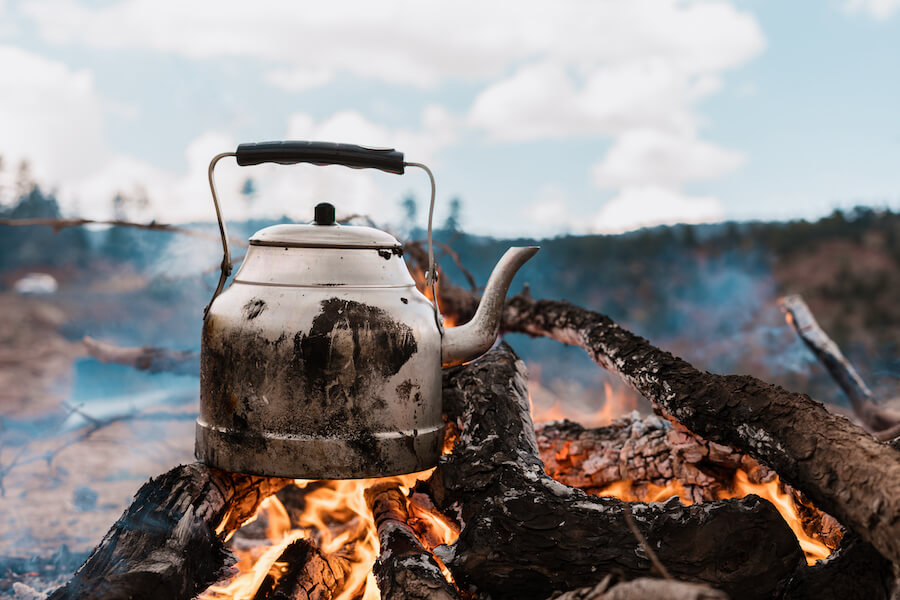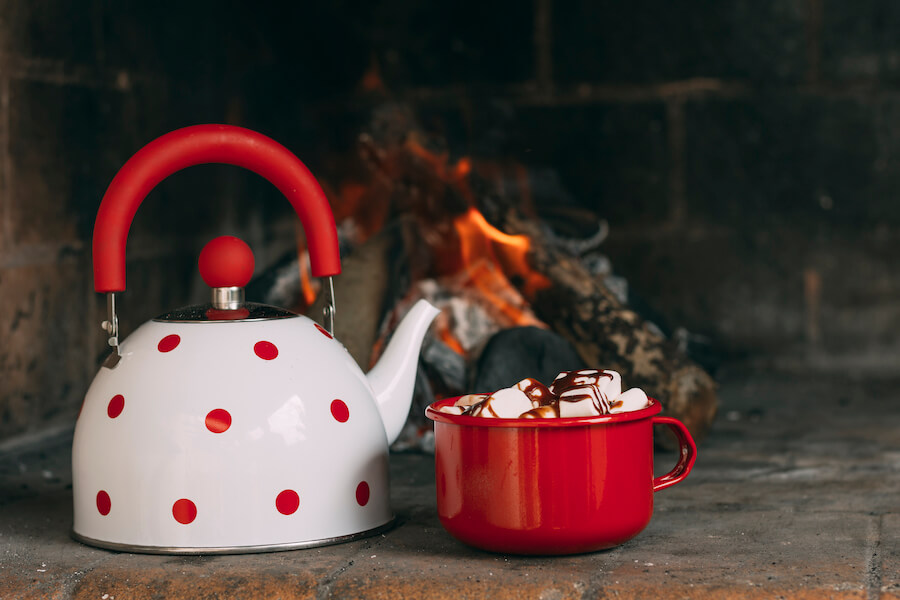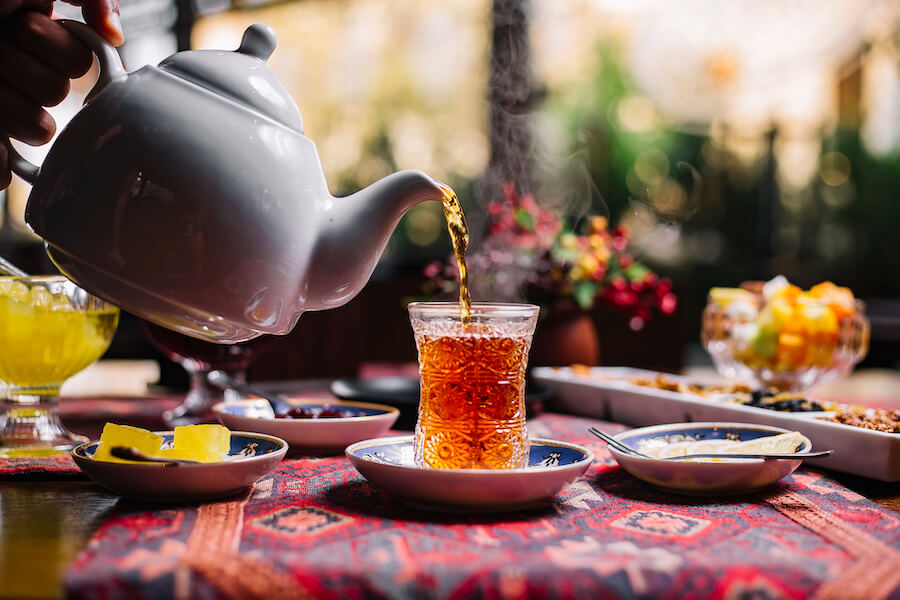Welcome to the intriguing world of tea kettles, where the humble kitchen appliance meets the complexities of safety concerns. If you’ve ever wondered whether a burnt tea kettle could be toxic, you’re not alone.

This blog post will dive deep into this hot topic and explore the dangers lurking in a neglected kettle’s shadows. From understanding the materials that make up your kettle to learning how to prevent burns and maintain its safety, we’ve got you covered.
So, please grab a cup of your favorite brew, settle in, and unravel the mysteries of tea kettle safety together.
The Tea Kettle and Its Materials
Regarding tea kettles, the materials they’re made of play a pivotal role in their safety. Let’s look at the materials commonly used in tea kettle construction and how they can impact your safety.
1. Stainless Steel
Stainless steel tea kettles are a popular choice due to their durability and resistance to rust and corrosion.
They’re generally safe when used correctly, but even stainless steel can pose risks if exposed to extremely high temperatures for extended periods. Burnt stainless steel can release harmful substances into your tea or water.
2. Ceramic
Ceramic tea kettles add a touch of elegance to your kitchen. They are safe when used within their recommended temperature limits. However, overheating a ceramic kettle can crack or shatter, posing a different safety risk.
3. Aluminum
Aluminum tea kettles are lightweight and heat up quickly.
However, they are more prone to corrosion and wear over time. If the protective layer inside an aluminum kettle becomes damaged, it can lead to aluminum leaching into your water, which can be harmful in excessive amounts.
4. Copper
Copper tea kettles have excellent heat conductivity but are rarely used today due to safety concerns. Overheating a copper kettle can release toxic copper ions, which are harmful when ingested.
The Dangers of Burnt Tea Kettles
Burnt tea kettles can be more than just a kitchen mishap; they pose significant health and safety risks. Let’s explore these dangers in detail:
1. Health Risks
When a tea kettle is burnt, the materials it’s made from can undergo chemical changes. For instance, if you have a stainless steel kettle, excessive heat can cause the steel to release harmful compounds into your tea or water.
Consuming these compounds may lead to health issues, including gastrointestinal problems or metal poisoning.
2. Release of Toxic Substances
Burnt materials can release toxic fumes or substances into the air. In the case of non-stick coatings commonly found in some kettles, such as Teflon, overheating can produce poisonous fumes known to be harmful when inhaled.
3. Impact on Tea or Water Quality
A burnt kettle can significantly affect the taste and quality of your tea or water. You may notice an unpleasant metallic taste or an off-putting odor, making your favorite beverage unenjoyable.
It’s crucial to understand that the risks associated with burnt tea kettles should not be taken lightly. If you’ve ever experienced a burnt kettle, it’s essential to address the issue promptly and prevent it from happening again.
Preventing Tea Kettle Burns

Preventing tea kettle burns and ensuring the safety of your kitchen appliance is paramount. By following some simple guidelines, you can maintain your kettle’s integrity and keep it safe to use:
1. Proper Maintenance and Cleaning
Regularly clean your tea kettle to prevent residue buildup. Use mild detergents and a soft cloth to remove stains and deposits. For hard-to-reach spots, a vinegar-water solution works wonders. Ensure thorough rinsing to remove any cleaning agents.
2. Avoid Overheating
Never leave your kettle unattended while it’s on the stove or plugged in. Overheating not only damages the kettle but can also lead to dangerous situations. Always follow the manufacturer’s instructions regarding temperature limits and usage guidelines.
3. Safe Usage Practices
Handle your kettle with care. Avoid using metal utensils that could scratch or damage the interior. When filling your kettle, only add the necessary amount of water to avoid overfilling, which can lead to boiling water spilling out when heated.
4. Regular Inspection
Periodically inspect your kettle for signs of wear and tear. Look for any damage, rust, or burnt areas. If you notice any issues, replacing the kettle is best to ensure your safety.
By taking these precautions and maintaining your tea kettle properly, you can effectively reduce the risk of burns and ensure that your kettle remains a safe and reliable part of your kitchen.
Understanding the Importance of Material Choice
The material your tea kettle is made from is critical to its safety and performance. Each material has its own set of advantages and potential drawbacks. Let’s explore the importance of material choice:
1. Stainless Steel
Pros: Stainless steel kettles are durable, resistant to rust and corrosion, and don’t react with most liquids. They are generally considered safe for boiling water.
Cons: Prolonged exposure to extremely high heat can cause stainless steel to release harmful compounds. Regular maintenance is crucial to prevent this.
2. Ceramic
Pros: Ceramic kettles are aesthetically pleasing and excellent for retaining heat. They don’t react with liquids and are safe when used within their temperature limits.
Cons: They can be fragile and are prone to cracking or shattering if exposed to extreme temperature changes.

3. Aluminum
Pros: Aluminum kettles heat up quickly and are lightweight. They are safe when used correctly.
Cons: Over time, aluminum can rust and, if not properly maintained, may lead to aluminum leaching into your water.
4. Copper
Pros: Copper kettles have excellent heat conductivity and a traditional appeal.
Cons: They are rarely used today due to the potential release of toxic copper ions when overheated. They require extra care and maintenance.
When choosing a tea kettle, consider your preferences, but prioritize safety. Ensure the material aligns with your needs and usage patterns. Regularly inspect your kettle and practice responsible usage to maintain its security, regardless of the material.
Frequently Asked Questions
1. Can I use a burnt tea kettle if I clean it thoroughly?
While cleaning a burnt tea kettle can help remove some residue, it’s essential to assess the extent of the damage. If the kettle’s material is compromised, it’s safer to replace it, as cleaning may not fully mitigate the risks associated with burnt kettles.
2. What should I do if I suspect my tea kettle is burnt?
If you suspect your tea kettle is burnt or has visible damage, stop using it immediately. Inspect it for signs of wear or damage. If significant damage or unsure, it’s best to err on caution and replace the kettle.
3. Are there any home remedies to clean a burnt tea kettle?
Common home remedies include using vinegar and water or baking soda and water to help remove burnt stains. However, these remedies may not fully restore the kettle’s safety if the material has been compromised.
4. How can I prevent my tea kettle from burning in the first place?
Prevention is key. Avoid leaving your kettle unattended while on the stove, follow manufacturer guidelines for temperature limits, and clean your kettle regularly. Proper maintenance and responsible usage can significantly reduce the risk of burning.
5. Are there any materials that are entirely safe from burning?
No material is entirely immune to burning if subjected to extreme heat for extended periods. However, some materials, like stainless steel and ceramic, are more heat-resistant and less prone to damage than others.
Conclusion:
The tea kettle is special in kitchen essentials, offering warmth and comfort with every brew. Yet, the safety of this humble appliance should never be overlooked.
We’ve explored the potential dangers of burnt tea kettles, the significance of material choice, and practical prevention tips. Remember, a burnt kettle can compromise your health, affect the quality of your beverages, and even release toxic substances.
Prioritizing proper maintenance, safe usage, and periodic inspections are your best allies in keeping your tea kettle safe. So, as you enjoy your next cup of tea, do so with the confidence that you’re brewing it in a safe and reliable vessel.
